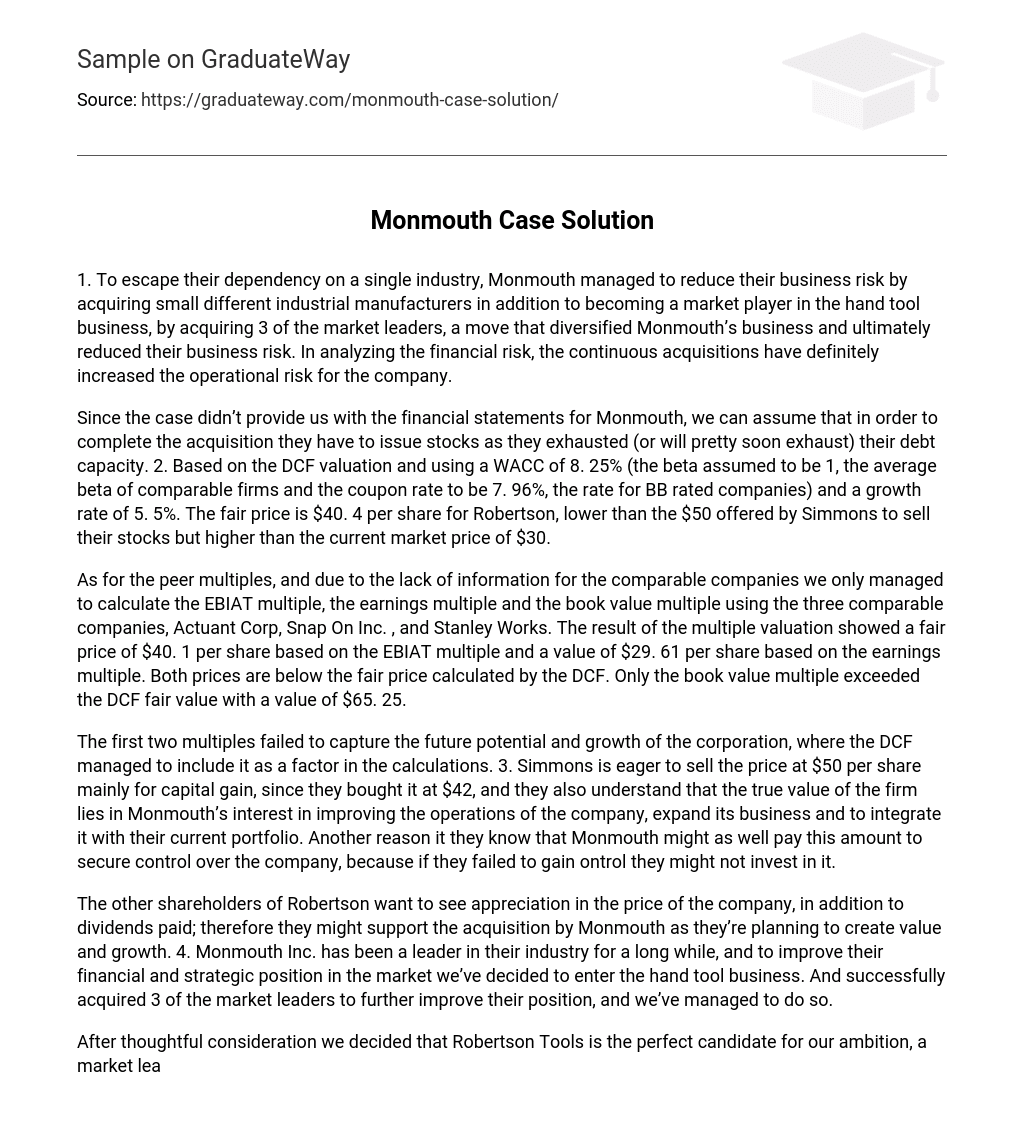1. To escape their dependency on a single industry, Monmouth managed to reduce their business risk by acquiring small different industrial manufacturers in addition to becoming a market player in the hand tool business, by acquiring 3 of the market leaders, a move that diversified Monmouth’s business and ultimately reduced their business risk. In analyzing the financial risk, the continuous acquisitions have definitely increased the operational risk for the company.
Since the case didn’t provide us with the financial statements for Monmouth, we can assume that in order to complete the acquisition they have to issue stocks as they exhausted (or will pretty soon exhaust) their debt capacity. 2. Based on the DCF valuation and using a WACC of 8. 25% (the beta assumed to be 1, the average beta of comparable firms and the coupon rate to be 7. 96%, the rate for BB rated companies) and a growth rate of 5. 5%. The fair price is $40. 4 per share for Robertson, lower than the $50 offered by Simmons to sell their stocks but higher than the current market price of $30.
As for the peer multiples, and due to the lack of information for the comparable companies we only managed to calculate the EBIAT multiple, the earnings multiple and the book value multiple using the three comparable companies, Actuant Corp, Snap On Inc. , and Stanley Works. The result of the multiple valuation showed a fair price of $40. 1 per share based on the EBIAT multiple and a value of $29. 61 per share based on the earnings multiple. Both prices are below the fair price calculated by the DCF. Only the book value multiple exceeded the DCF fair value with a value of $65. 25.
The first two multiples failed to capture the future potential and growth of the corporation, where the DCF managed to include it as a factor in the calculations. 3. Simmons is eager to sell the price at $50 per share mainly for capital gain, since they bought it at $42, and they also understand that the true value of the firm lies in Monmouth’s interest in improving the operations of the company, expand its business and to integrate it with their current portfolio. Another reason it they know that Monmouth might as well pay this amount to secure control over the company, because if they failed to gain ontrol they might not invest in it.
The other shareholders of Robertson want to see appreciation in the price of the company, in addition to dividends paid; therefore they might support the acquisition by Monmouth as they’re planning to create value and growth. 4. Monmouth Inc. has been a leader in their industry for a long while, and to improve their financial and strategic position in the market we’ve decided to enter the hand tool business. And successfully acquired 3 of the market leaders to further improve their position, and we’ve managed to do so.
After thoughtful consideration we decided that Robertson Tools is the perfect candidate for our ambition, a market leader who has a lot of growth potential to start with. We believe that by acquiring Robertson we can manage it more efficiently, and when combining it with our other companies we’ll manage to reduce overlapping expenses and distribution costs. Robertson also will create value for Monmouth, as it will help in reducing the cyclicality of the industry and help in appreciating the stock value in improving the market prospective for it.
The forecasted net income and EPS is growth in the next five years even if we didn’t invest in Robertson, we believe that Robertson will create value for us in improve our business even more, in addition to us improving the position of Robertson by combining forces and making the operations more efficient and reduce the production lines to help focus in specific market sectors for each firm. We believe that combining forces will benefit all of us, will help us achieving the true potential of Robertson by integrating it with our current business, and our long term strategy.





